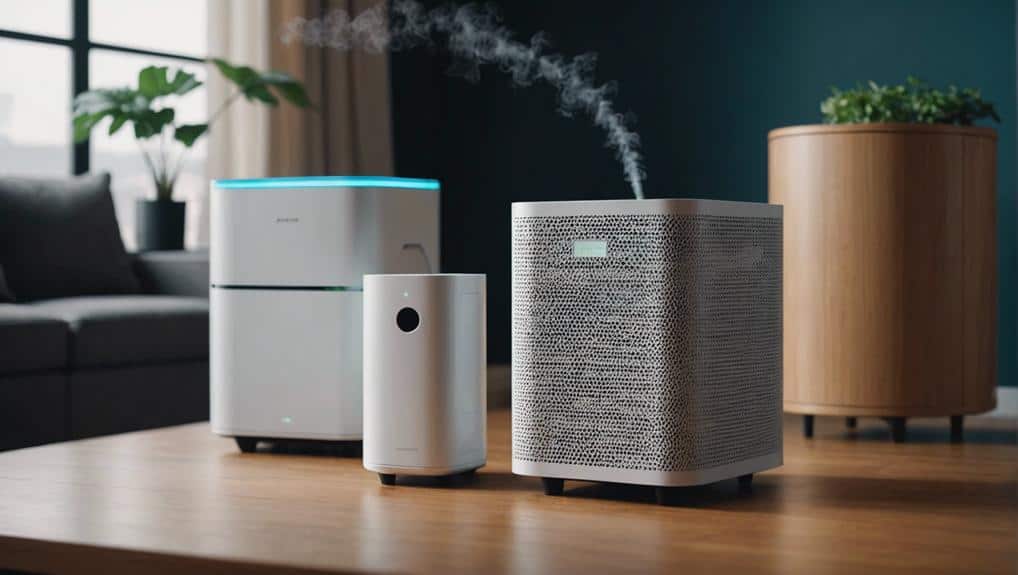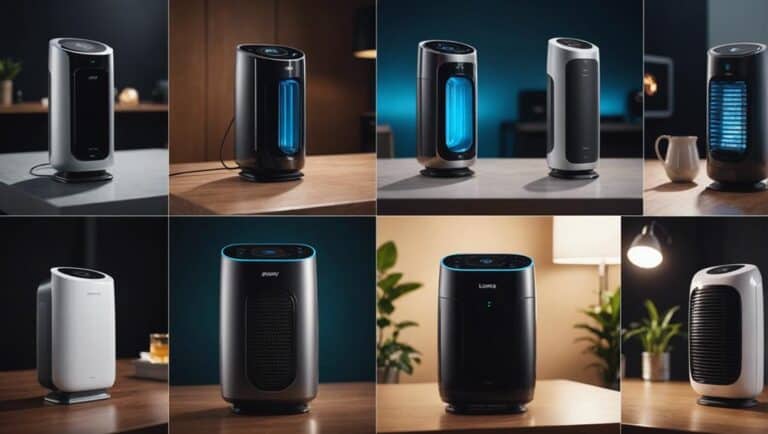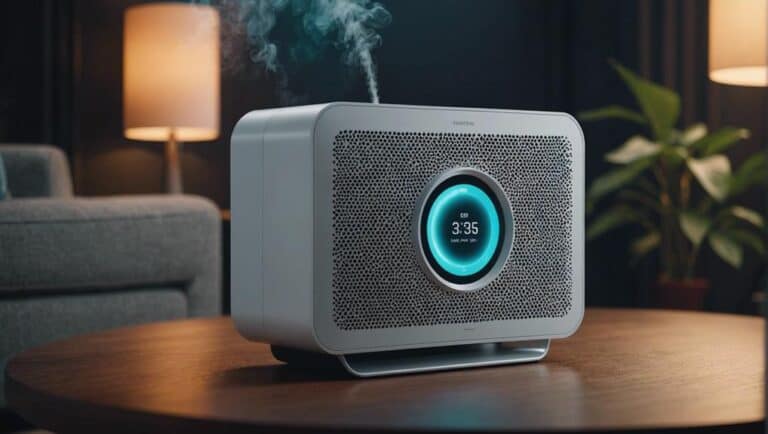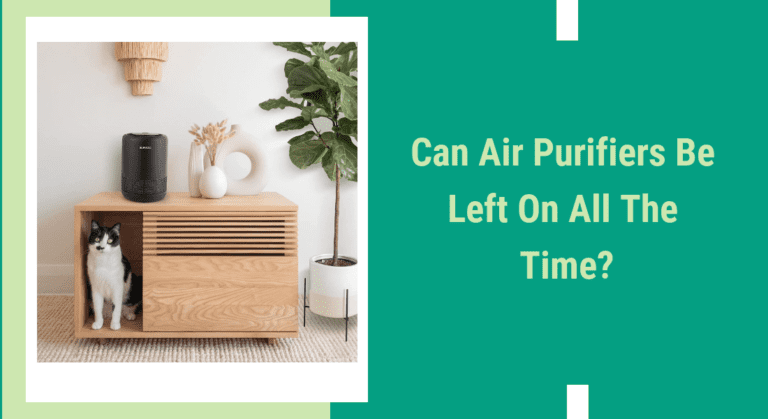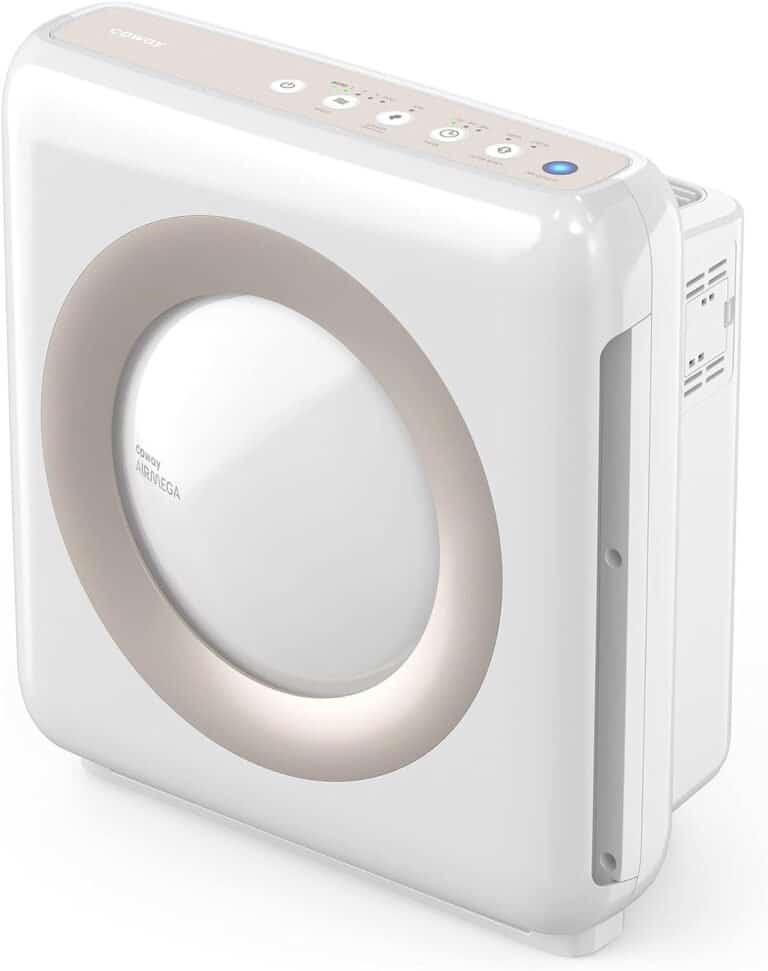Top 10 Air Purifier Ideas for Fresher Air
As we explore the domain of air purification, we encounter a multitude of innovative and practical solutions that promise fresher air within our living spaces. From the simplicity of homemade air filters to the elegance of using beeswax candles for cleaner air, each idea holds the potential to transform our indoor environments. Join us in uncovering these top 10 air purifier ideas, where cost-effectiveness meets effectiveness, and where a breath of clean air is just a step away.
Homemade Air Filter
Let’s assemble a homemade air filter using a box fan and a high-quality furnace filter for effective reduction of airborne contaminants.
By combining a box fan with a furnace filter, we can efficiently capture dust, pollen, and pet dander, improving the air quality in our living spaces. This cost-effective solution rivals commercial air purifiers in performance, making it a practical choice for those seeking cleaner air.
The DIY air filter is quick to set up, requiring only a few minutes of your time, and is particularly suitable for smaller rooms. Regular maintenance is key to ensuring the optimum functioning of this homemade air filter. Remember to change the furnace filter at recommended intervals to uphold its air filtration efficiency.
Taking control of the air we breathe is essential, and this DIY approach offers a straightforward yet effective method to combat common airborne pollutants.
Natural Air Purification Methods
Indoor plants, activated charcoal, beeswax candles, Himalayan salt lamps, and regular ventilation are effective holistic methods for purifying the air in your home.
Indoor plants such as spider plants, aloe vera, and peace lilies act as natural air filters, removing toxins like formaldehyde and benzene. Activated charcoal and bamboo charcoal bags are great at absorbing odors and pollutants, while beeswax candles release negative ions that neutralize harmful particles.
Himalayan salt lamps can enhance air quality by emitting negative ions and reducing electromagnetic radiation. Additionally, opening windows regularly allows for fresh air circulation, reducing indoor air pollutants and enhancing the overall atmosphere.
These natural air purification methods work well alongside traditional air purifiers equipped with HEPA filters and activated carbon filters, providing a holistic approach to maintaining clean and fresh indoor air. Incorporating these natural solutions can help you take control of your indoor air quality for a healthier living environment.
DIY Air Purifier Placement
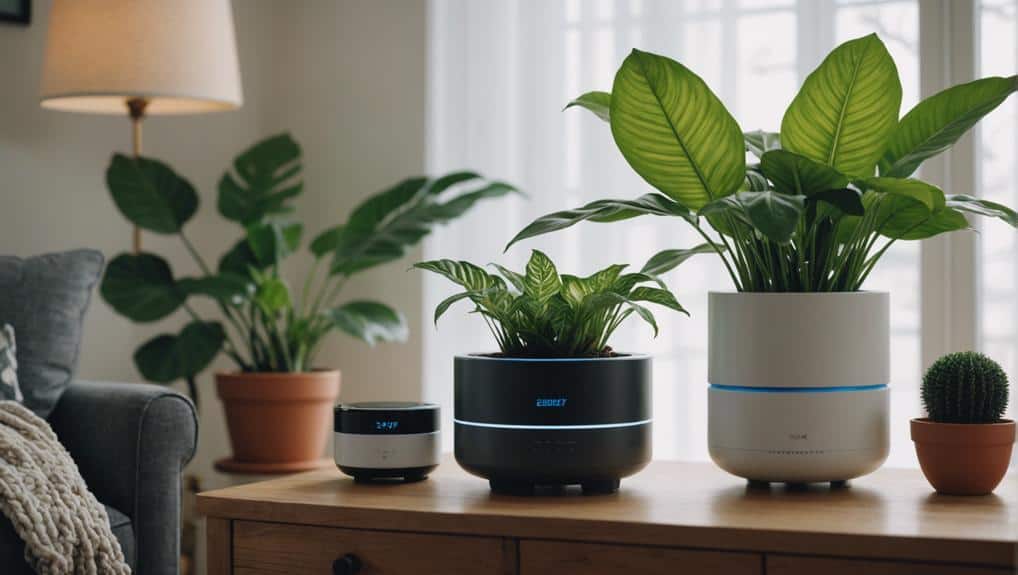
Let’s talk about the best ways to position your DIY air purifier for maximum effectiveness.
Placing it centrally in the room guarantees proper air circulation, while keeping it unobstructed by furniture or obstacles enhances its performance.
Additionally, considering the size of the room and the elevation of the purifier can impact airflow and distribution of purified air.
Ideal Placement Tips
For maximum effectiveness, position your DIY air purifier strategically near potential sources of pollution to efficiently capture contaminants. Placing the air purifier in areas like the kitchen or near smoking spots can help in effectively removing harmful particles.
To guarantee proper functioning, avoid obstacles and electronic devices that may hinder airflow and reduce the purifier’s efficiency. The ideal placement includes the center of the room for improved air circulation and coverage. Make sure that the air purifier is at an appropriate height to capture airborne particles without obstruction.
Regular monitoring of air quality in different room areas will help determine the most suitable placement for your DIY air purifier, ensuring a healthier environment.
Room-Specific Air Purification
Placing air purifiers strategically in different rooms can greatly enhance indoor air quality by targeting specific sources of pollution.
In the bedroom, an air purifier can help reduce allergens like dust mites and pet dander, promoting better sleep quality.
For the kitchen, positioning the air purifier near cooking areas effectively removes cooking odors and volatile organic compounds (VOCs).
In the living room, placing the air purifier strategically helps eliminate smoke particles from candles, fireplaces, or tobacco smoke.
In home offices, positioning the air purifier near printers and electronics traps airborne particles such as toner dust and pet hair, improving air quality.
In the nursery or baby’s room, placing the air purifier away from the crib but near the changing table helps maintain clean air for the infant.
Size Considerations for Placement
Considering the room size is important when determining the best placement for an air purifier to guarantee efficient air circulation and purification. Larger rooms may benefit from air purifiers with higher CADR to ensure effective air filtration.
Placing the air purifier strategically near sources of pollution, like pet areas or kitchens, can target specific areas for cleaner air. It’s essential to avoid obstacles that may block airflow, such as electronic devices or furniture, as this can reduce the purifier’s effectiveness.
Houseplants for Air Quality
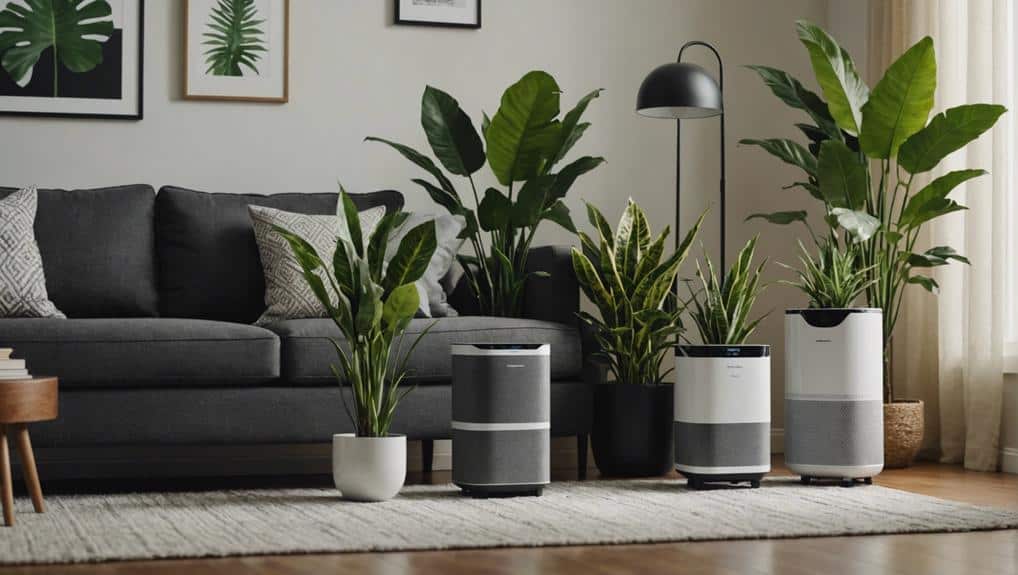
Houseplants such as spider plants, peace lilies, and aloe vera play an essential role in enhancing indoor air quality by naturally absorbing toxins and releasing oxygen. When it comes to improving indoor air quality, these plants are key players in creating a healthier living environment. Here are some reasons why houseplants are beneficial for air quality:
- Natural Air Purifiers: Identified by NASA’s Clean Air Study, houseplants act as natural air purifiers, eliminating common pollutants like formaldehyde, benzene, and trichloroethylene.
- Specific Pollutant Removal: Spider plants target carbon monoxide and xylene, while peace lilies excel at removing ammonia and formaldehyde.
- Moisture and Air Quality: Aloe vera not only absorbs formaldehyde and benzene but also adds moisture to the air, benefiting respiratory health.
- Enhanced Air Quality: By incorporating these houseplants into your indoor space, you can reduce toxins, improve air quality, and create a more health-conscious environment.
Essential Oils for Fresh Air
To enhance the freshness of indoor air, incorporating essential oils like lavender, eucalyptus, and peppermint can be a natural and effective solution. These oils not only freshen the air but also have antibacterial properties, contributing to a cleaner environment. Diffusing essential oils can help eliminate odors and create a pleasant aroma in your space. Certain oils like eucalyptus can even help clear the airways, promoting easier breathing. Additionally, using a diffuser with essential oils can also promote relaxation and reduce stress levels, enhancing your overall well-being.
| Essential Oils | Benefits |
|---|---|
| Lavender | Relaxation and Calming |
| Eucalyptus | Clearing Air Passages |
| Peppermint | Invigorating Scent |
| Tea Tree | Antibacterial Properties |
Activated Charcoal Air Purifiers
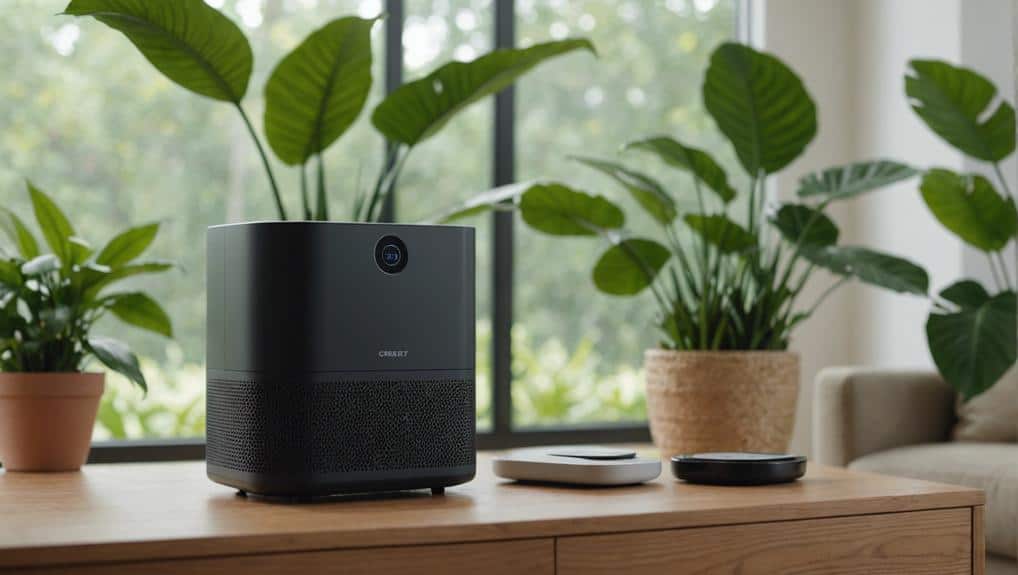
Activated charcoal air purifiers utilize a porous form of carbon to effectively trap odors, chemicals, and volatile organic compounds (VOCs) in the air. These purifiers are highly efficient in odor removal and improving the overall air quality in indoor environments.
Here are some key points about activated charcoal air purifiers:
- Odor Removal: They’re effective in neutralizing unwanted smells like smoke, pet odors, and cooking fumes, creating a fresher indoor environment.
- VOCs Trapping: Activated charcoal air purifiers excel at trapping volatile organic compounds, ensuring a cleaner and healthier indoor atmosphere.
- Efficient: These purifiers are efficient and cost-effective, requiring only occasional replacement of the activated charcoal filters to maintain excellent performance.
- Safe and Natural: They don’t release any harmful byproducts into the air, offering a safe and natural solution for enhancing air quality.
Incorporating activated charcoal air purifiers into your space can provide you with more control over the air you breathe, ensuring a fresher and cleaner indoor environment.
Salt Lamps for Air Cleansing
Salt lamps are intriguing additions to our homes, emitting negative ions that purportedly cleanse the air.
We can explore the benefits of these lamps, how to effectively use them, and the different varieties available to consumers.
Let’s shed some light on how salt lamps can contribute to fresher and cleaner air in our living spaces.
Benefits of Salt Lamps
Using their hygroscopic properties, salt lamps attract water molecules from the environment and trap pollutants, contributing to a fresher indoor atmosphere. Salt lamps offer several benefits for air purification:
- Reduction of airborne contaminants like dust, pollen, and mold spores.
- Emission of negative ions that can neutralize positive ions in the air, potentially improving indoor air quality.
- Limited scientific evidence on effectiveness, but many users report noticeable differences in air quality.
- Creation of a soothing ambiance and potential respiratory benefits for those sensitive to pollutants.
Salt lamps provide a natural and aesthetically pleasing way to enhance the air quality in your living space.
Using Salt Lamps
By harnessing their unique hygroscopic properties, salt lamps have been utilized to enhance air quality by attracting water molecules and trapping airborne impurities like dust and pollen. While salt lamps may not match the efficiency of traditional air purifiers, they can still play a role in improving the overall indoor environment.
Placing salt lamps strategically in areas with good air circulation can maximize their air cleansing effects. Beyond their air purification benefits, salt lamps also create a calming and soothing ambiance, making them a popular choice for enhancing room atmosphere.
For those seeking to take control of their indoor air quality, incorporating salt lamps into their space can be a simple yet effective step towards fresher air.
Salt Lamp Varieties
Exploring the diverse range of salt lamp varieties enhances the air cleansing experience in indoor spaces. Salt lamps, made from Himalayan salt crystals, attract water molecules and trap particles like dust. The heat from the lamp releases negative ions, countering positive ions from electronic devices. Users claim salt lamps can alleviate allergies, asthma, and respiratory conditions by purifying the air. While scientific evidence is limited, many find salt lamps aesthetically pleasing and calming. Different colors and sizes are available, adding a warm glow to any room and potentially contributing to a more relaxing atmosphere.
- Salt lamps are made from Himalayan salt crystals.
- They attract water molecules and trap particles like dust.
- Heat from the lamp releases negative ions.
- Users claim salt lamps can alleviate allergies, asthma, and respiratory conditions.
UV-C Light Air Purification
UV-C light air purification swiftly eliminates germs, bacteria, and viruses in the air, ensuring a healthier indoor environment. This technology utilizes ultraviolet light to target and destroy harmful pathogens, making it an effective method for enhancing indoor air quality. By installing a UV-C light air purifier, you gain greater control over the cleanliness of your breathing environment, reducing the risk of illnesses spreading through the air. The disinfectant properties of UV-C light have been extensively studied and proven, providing reassurance of its effectiveness in sanitizing the air you breathe. With UV-C light air purification, you can create a safer and more hygienic space for your family or coworkers.
| Benefits of UV-C Light Air Purification | |
|---|---|
| Swiftly eliminates germs and viruses | |
| Improves indoor air quality | |
| Reduces the spread of illnesses | |
| Acts as a powerful disinfectant | |
| Safe and efficient air sanitization |
Baking Soda Air Freshener
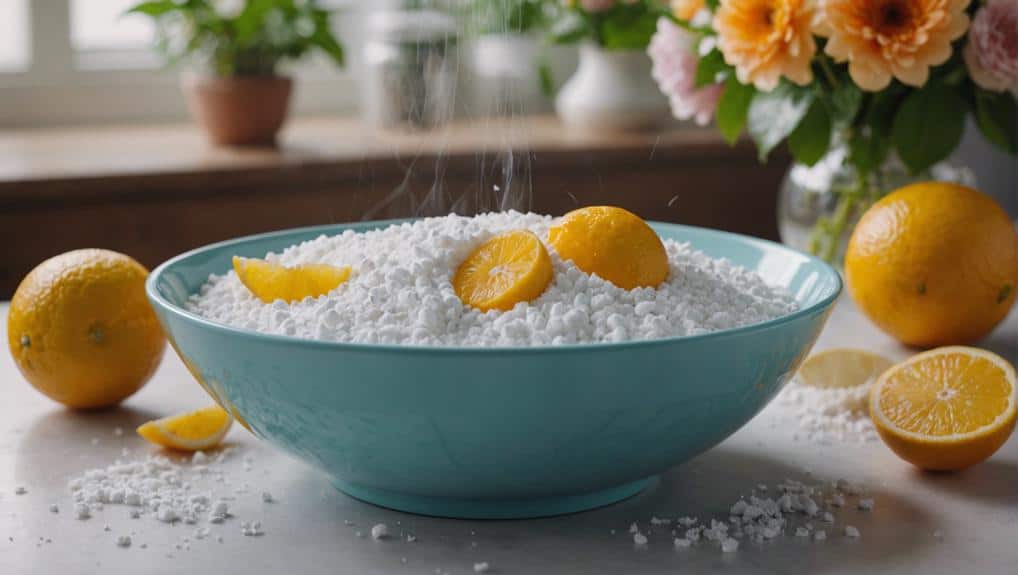
Let’s talk about creating our own DIY baking soda air fresheners!
Baking soda is a natural odor absorber that can help freshen up various spaces in our homes.
We can easily make these cost-effective and non-toxic air fresheners to maintain a pleasant environment for everyone.
DIY Baking Soda
Placing open containers of baking soda around the house can effectively absorb odors and improve indoor air quality. Here are some ways to utilize baking soda as a DIY air freshener:
- Mix with Essential Oils: Create a personalized scent by combining baking soda with your favorite essential oils.
- Carpet Deodorizer: Sprinkle baking soda on carpets before vacuuming to eliminate trapped odors.
- Refrigerator Refresher: Place an open box of baking soda in the refrigerator to neutralize odors.
- Shoe Odor Eliminator: Keep shoes fresh by sprinkling baking soda inside and letting it sit overnight.
These simple methods provide a cost-effective and efficient way to refresh the air in your living space.
Natural Air Freshener
Creating a natural air freshener with baking soda offers a simple and effective way to eliminate odors and maintain a fresh indoor environment. Baking soda air fresheners are excellent for controlling odors from smoke, pets, and cooking. By absorbing and neutralizing unwanted smells, these natural air fresheners contribute to a pleasant indoor atmosphere. Making your own baking soda air fresheners allows for customization with essential oils, giving you control over the scents in your home. Placing these air fresheners strategically around different areas guarantees thorough odor control. Regularly revitalizing or replacing them guarantees continuous air purification. See the table below for a visual representation of how baking soda air fresheners can help in managing indoor odors:
| Area | Baking Soda Air Freshener Scent | Benefits |
|---|---|---|
| Kitchen | Citrus | Absorbs cooking odors |
| Living Room | Lavender | Neutralizes pet smells |
| Bathroom | Eucalyptus | Eliminates bathroom odors |
Beeswax Candles for Cleaner Air
How can beeswax candles contribute to cleaner air in your living space?
Beeswax candles are a natural and effective way to purify the air, thanks to their ability to release negative ions that bind with toxins and pollutants. Here are some key points to keep in mind:
- Beeswax candles offer a natural alternative to paraffin candles, which can emit harmful chemicals during burning.
- These candles have a pleasant, sweet scent and don’t produce soot or smoke, unlike other types of candles.
- The negative ions released by beeswax candles can help counteract the positive ions from electronic devices, leading to improved air quality.
- Choose pure beeswax candles without any additives for optimal air purification benefits.
Conclusion
To sum up, improving indoor air quality doesn’t have to be complicated or expensive. With these top 10 air purifier ideas, you can create a fresher and healthier living environment for you and your family.
Whether you choose DIY methods, natural purification techniques, or specialized air purification tools, there are plenty of options to suit your needs and preferences. Take small steps to enhance the air you breathe and enjoy a cleaner and more pleasant atmosphere in your home.
